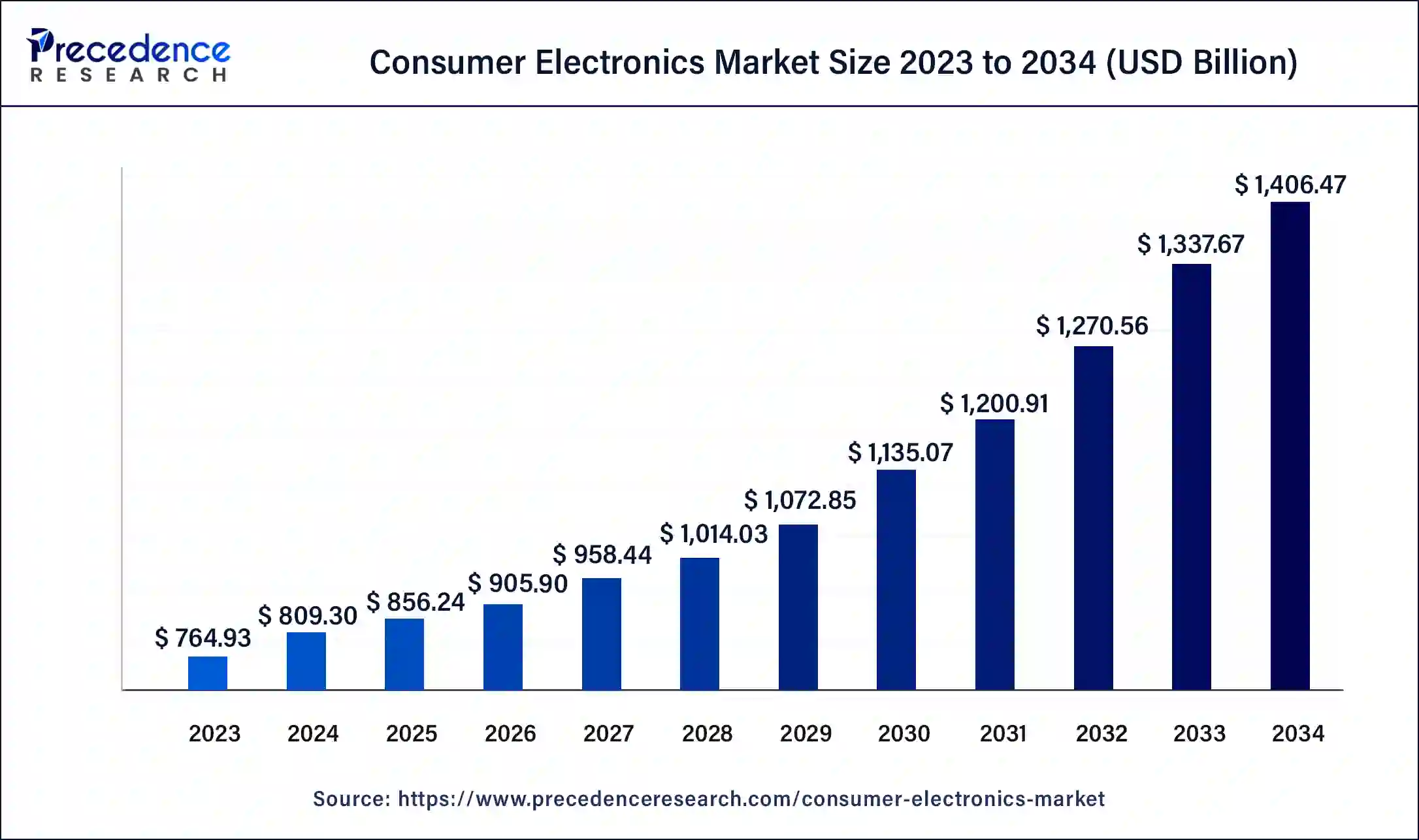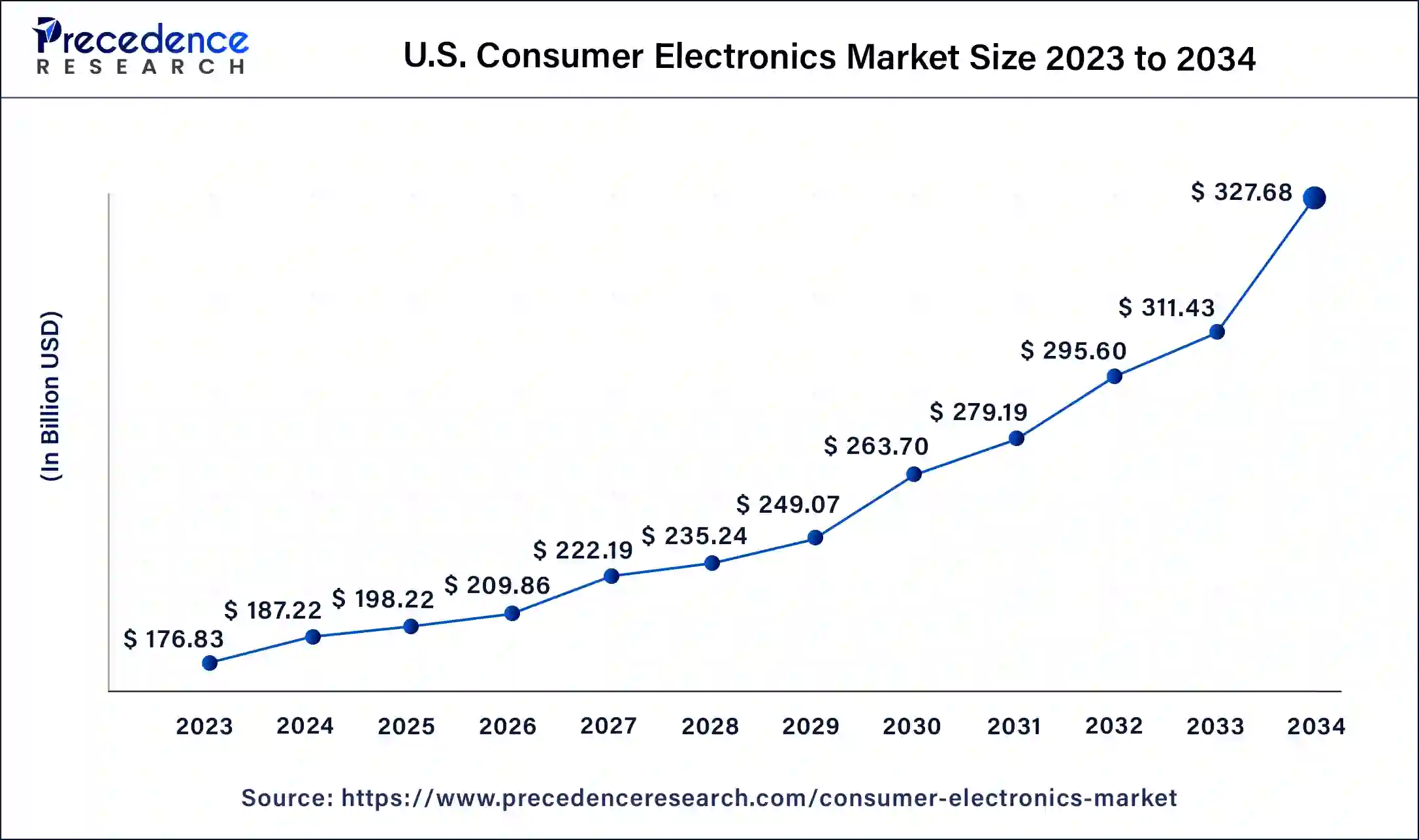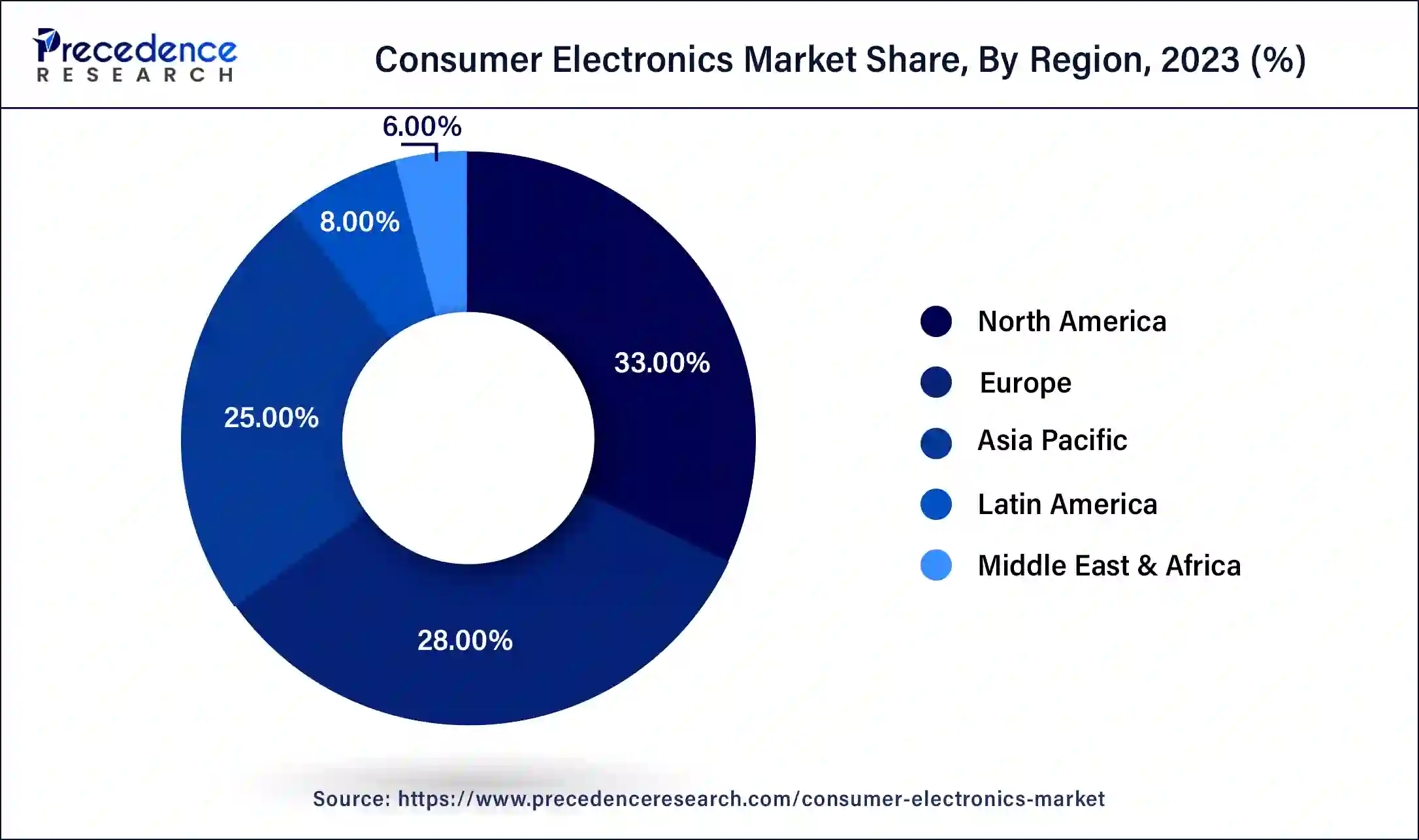What is the Consumer Electronics Market Size?
The global consumer electronics market size is calculated at USD 856.24 billion in 2025 and is predicted to increase from USD 905.90 billion in 2026 to approximately USD 1,474.14 billion by 2035, expanding at a CAGR of 5.58% from 2026 to 2035.

Market Highlights
- By application, the personal segment has reached around 80% of total revenue share in 2025.
- By product, the electrocnics devices has held 61% revenue share in 2025.
- North America has accounted 39% revenue share in 2025.
- Asia Pacific consumer electronics market size was valued at USD 413 billion in 2025.
- The professional application segment is registering at a CAGR of 4.8% from 2026 to 2035.
What is the Consumer Electronics Market?
Consumer electronics are highly penetrated consumer products across the globe. Basically consumer electronics refer to the electronic products for non-commercial use. The increased adoption of wider varieties of consumer electronics among the household sector has significantly boosted the growth of the global consumer electronics market. Manufacturers are heavily investing towards the integration of various digital technologies in the consumer electronic products and increasingly focusing on providing high quality experiences to the consumers.
The miniaturization of the electronic products is gaining rapid traction across the globe. The portability and lightweight electronic goods are gaining popularity among the consumers. Therefore, the adoption of miniature electric components is driving the growth of the global consumer electronics market across the globe. The shifting focus of the manufacturers towards the development of easy to use and convenient products is expected to drive the sales of the consumer electronics across the globe. The most popular consumer electronic products include mobile devices, laptops, computers, televisions,smartphones, refrigerators, home appliances, and wearable devices.
How is AI contributing to the Consumer Electronics Industry?
Artificial Intelligenceelevates the level of consumer electronics by making gadgets much smarter, more personalized, and more intuitive through the implementation of features like intelligent assistants, predictive suggestions, and tailored recommendations. It gets to know the user habits, takes over the boring tasks, and makes sure the system is secure while also driving the performance of smart homes, wearable devices, and communication gadgets.
AI is there for the product design, the manufacturing process that involves fraud detection, and health monitoring, while at the same time allowing us to interact through natural language, gesture recognition, and facilitating the integration of the connected systems for better usability and convenience.
Consumer Electronics Market Growth Factors
The surging investments by the top market players in the research and development and innovation are resulting in the new product launches with latest and innovative features. For example, Philips invested more than US$ 500 million in the first quarter of 2022 towards the research and development purpose. Moreover, the development of energy efficient electronic devices has gained significant traction among the consumers owing to the increased awareness regarding the electricity consumption and its harmful effects on the environment. Moreover, the surging investments in developing distribution networks and expansion across the globe are propelling the consumer electronics market growth.
- The rising disposable income of the consumers, improvement in the standard of living, and growing demand for the home improvement products is augmenting the market growth.
- The market is witnessing a rapid change in the technologies.
- The introduction of latest technologies such as artificial intelligence, internet of things, Wi-Fi, Bluetooth, internet, augmented realty, virtual reality, and cloud computing is significantly influencing the consumer electronics market.
The outbreak of the COVID-19 pandemic in 2020 had a negative impact on the consumer electronics market. The lockdown measures and travelling restrictions imposed by the government resulted in the supply chain disruptions, lack of labor, and closure of the production facilities. However, certain segments like dishwashers and laptops segments witnessed a positive growth owing to the increased expenditure on the home improvement products and rising trend of work from home. Furthermore, the e-commerce platforms played an exceptional role in the sales of the consumer electronics during the pandemic across the globe. The increasing dependence on the digital and electronic products for the personal and professional purposes is expected to have a significant impact on the market growth during the forecast period.
Consumer Electronics Market Outlook
Technology advancements and quality-of-life improvements play an ongoing role in market expansion and new product development.
The industry concerns are now recycled materials, energy-efficient designs, easy-to-repair, and long-lasting device usage.
The region of Asia-Pacific is consolidating its market, while the rest are assisted through digital lifestyles and raising consumer tech awareness.
The venture capitalists Lux Capital, Upfront, Morpheus Ventures, and Alsop Louie Partners support the extension with the participation of Apple, Samsung, and Sony.
Innovative startups are bringing new human-device interaction concepts and creative device engineering through collaborative innovation networks.
Market Scope
| Report Coverage | Details |
| Market Size in 2025 | USD 856.24 Billion |
| Market Size in 2026 | USD 905.90 Billion |
| Market Size by 2035 | USD 1,474.14 Billion |
| Market Growth Rate from 2026 to 2035 | CAGR of 5.58% |
| Largest Market | North America |
| Base Year | 2025 |
| Forecast Period | 2026 to 2035 |
| Segments Covered | Product, Application, Technology, Distribution Channel, and Region |
| Regions Covered | North America, Europe, Asia-Pacific, Latin America, and Middle East & Africa |
Consumer Electronics Market Segment Insights
Product Insights
The smartphones segment accounted for a revenue share of more than 60% and dominated the global consumer electronics market. The increased product acceptance, high adoption of the smartphones among the global consumers, and product innovations by the manufacturers are the major reasons behind the growth of this segment. The major three operating platforms - Android, iOS, and Windows dominate the global smartphone market. The multi-functional features and the development of miniature and cost-effective smartphones has driven the growth of this segment. The burgeoning demand for the smartphones in the developing regions is expected to further drive the growth of this segment during the forecast period. Furthermore, the emergence of 4G and 5G technologies along with the strong developments in the IT and telecommunications infrastructure is expected to have a significant impact on the market growth.
Distribution Channel Insights
The global consumer electronics market was dominated by the offline segment in 2025. The presence of huge number of consumer electronic stores, small retail stores, supermarkets, and specialty electronic stores made the offline segment the most preferred distribution channel for the customers. Most of the customers increasing prefer the offline channels for buying electronic products owing to the availability of immediate gratification and the assistance of specialized sales persons during the purchase.
The online is estimated to be the fastest-growing segment during the forecast period. The rapid development of the IT and the telecommunications infrastructure, increased penetration of the online shopping platforms, significantly growing number of internet users, and increasing adoption of smartphones are the major factors that favors the growth of the online segment. The online sellers provides wider variety of products and brands, flexible payment options, easy return and exchange policies, quick home delivery, and 24/7 customer helpline services that attracts the customers to buy consumer electronic products online.
Consumer Electronics Market Regional Insights
The U.S. consumer electronics market size reached USD 198.22 billion in 2025 and is predicted to touch USD 343.65 billion by 2035, growing at a CAGR of 5.66% between 2026 to 2035.

U.S. Consumer Electronics Market Trends
The market is being driven mainly by the demand for integrated ecosystems, gaming systems, and computing devices. There is a scope for premium and AI-enabled products that are taking advantage of connected home technology and next-phase communication capabilities.
North America was the dominating market in 2025. The high disposable income of the consumers, huge demand for the luxury and premium products, high standard of living, higher adoption of the latest technologies, and the presence of the top players in the region are some of the prominent factors that has driven the North America consumer electronics market.
The area is witnessing very strong adoption, and all this is due to having modern technology admirers and also being able to afford it. There is a rise in demand for smart home devices, personal entertainment systems, and high-performance electronics that are all being supported by early innovation and good digital infrastructure.

Asia Pacific is estimated to be the fastest-growing market during the forecast period. Asia Pacific is witnessing strong economic growth owing to rapid industrialization. The favorable government policies in the countries like China and India is attracting huge FDIs in the region. The top companies are establishing their manufacturing units owing to the cheap availability of factors of production in this region. The China and India are becoming the global manufacturing hub for the electronic products. Furthermore, Taiwan and South Korea are among the top manufacturers of the consumer electronics across the globe. The rising disposable income of the consumers, presence of huge youth population, and improving standards of living are the prominent factors that are expected to drive the growth of the Asia Pacific consumer electronics market.
The region's growth is well underpinned by the continuous rise of income levels, urbanization, and the increasingly larger consumer base. The region is the foremost in the adoption and production of electronic devices, with excellent retail and technology acceptance.
China Consumer Electronics Market Trend
The country has become a notable manufacturing center with substantial local adoption, thus providing a good interrelation with support coming from technological developments in device integration and government plans. Retail and social commerce are growing, which consequently increases electronic consumption and allows more innovations in production capability and smart device design.
The market trend is towards sustainability, energy-efficient technology, and eco-friendly design, which are the key drivers of growth. The law pushes product durability, recyclability, and efficiency, which in turn causes innovation in eco-friendly electronic manufacturing and consumers' patterns of acceptance.
Germany Consumer Electronics Market Trends
The demand is based on the consumers' preference for high-quality engineered electronics and smart appliances. The market opportunity is in precision devices, premium visual and audio products, and environmentally aligned manufacturing on the right-to-repair and energy-efficient solutions.
Consumer Electronics Market Value Chain
The silicon wafers and specialty gases are obtained in a way that ensures quality consistency and at a price that is not a barrier to the manufacturing process.
Key Players: Shin-Etsu Handotai, SUMCO, Air Products & Chemicals, and Merck
The silicon wafers are transformed into circuits in an atmospheric-cleaned room, and the creation of the chips is done here.
Key Players: TSMC, Samsung
The intricate patterns are first formed on the wafers with light, followed by the removal of the material in selectively defined areas to create the structures.
Key Players: ASML (lithography equipment), Applied Materials (etching/deposition equipment), Lam Research
The silicon is doped with impurities and its properties modified, and then layers are deposited to complete the transistor architecture.
Key players: ASML, Applied Materials, Lam Research
The tested circuits are cut, then put into the casing and connected externally, after which they are ready for the final device integration.
Key players: ASE Technology Holding, Amkor Technology, and JCET Group.
Key Company Insights
The consumer electronics market is highly fragmented with the presence of numerous top market players. The most dominant players include Samsung, LG, Philips, Apple, Bajaj, Voltas, Hitachi, and Blue Star. These market players are investing heavily in the value-added services to gain competitive advantage and gain market share. Furthermore, these market players are engaging in various developmental strategies such as product launches, partnerships, joint ventures, and mergers to exploit the prevailing market opportunities.
Top Companies in the Consumer Electronics Market & Their Offerings
Provides an integrated ecosystem of iPhones, Macs, iPads, and wearables, seamlessly combining hardware, software, and services for the premium user experience.
Supplies digital cameras, lenses, printers, and imaging solutions, thus providing artists and amateurs alike with a wide range of products that offer great quality
Personal computers, laptops, monitors, and gaming solutions to deliver everyday performance systems for both daily activities and entertainment applications.
Other Major Companies
- Samsung Electronics Co., Ltd.
- Panasonic Corporation
- Sony Corporation
- Koninklijke Philips N.V.
- Lenovo Inc.
- Hewlett-Packard Company
- Oneplus
- AB Electrolux
- LG Corporation
- Google Inc.
- Microsoft Corporation
- Hitachi Ltd.
- Robert Bosch GmbH
- Sennheiser Electronics
- Siemens AG Logitech International S.A.
- OPPO
- ZTE Corporation
Recent Developments
- In November 2025, Wobble, a subsidiary of Indkal Technologies, launched the Wobble One smartphone in India, targeting the mid-range market with emphasis on performance, battery, and camera. (Source: businesstoday.in)
- In November 2025, Samsung Electronics announced that its latest products and services received multiple CES 2026 Innovation Awards from the Consumer Technology Association, underscoring its dedication to enhancing consumer technology experiences through performance, design, and intelligence. (Source: news.samsung.com)
- In August 2020,Samsung introduced its new AI-based washing machine that helps the user to customize washing cycles.
- In July 2020, LG introduced UltraGear Gaming Monitor. It was a 27-inch monitor and the first 4K IPS one millisecond GTG gaming monitor in the globe.
Segments Covered in the Report
By Product
- Smartphones
- Desktops
- Tablets
- Laptops & Notebooks
- Digital Cameras
- eReaders
- HDD
- Television
- Refrigerators
- Washing machine
- Air Conditioners
- Others
By Distribution Channel
- Online
- E-Commerce Websites
- Company-Owned Websites
- Offline
- Hypermarkets & Supermarkets
- Departmental Stores
- Specialty Stores
By Application
- Personal
- Professional
By Type
- Conventional
- Smart
By Technology
- Near Field Communication (NFC)
- Magnetic Secure Transmission (MST)
- Artificial Intelligence
- VR (Virtual Reality) Technology
- Generation PCL Technology
- Others
By Region
- North America
- Europe
- Asia-Pacific
- Latin America
- Middle East & Africa (MEA)
For inquiries regarding discounts, bulk purchases, or customization requests, please contact us at sales@precedenceresearch.com
Frequently Asked Questions
Tags
Ask For Sample
No cookie-cutter, only authentic analysis – take the 1st step to become a Precedence Research client




 sales@precedenceresearch.com
sales@precedenceresearch.com
 +1 804-441-9344
+1 804-441-9344